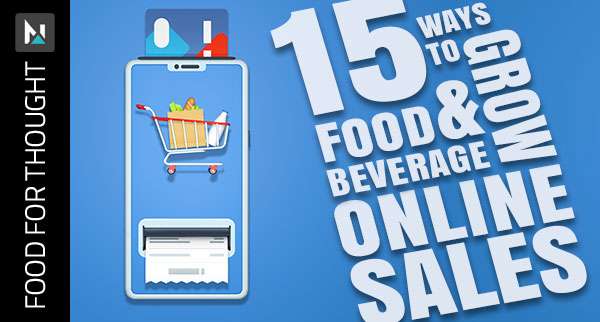Apr 5, 2023
Your Food Brand Vision as Marketing Plan
Do You Have a Long-Term Brand Vision?
How does marketing fit in your big-picture brand vision? Unfortunately, many food brands only see marketing as an expense – and a big one. But if you want to control your costs effectively while maximizing your results, it’s important to see marketing as an investment. Once you make this philosophical change, it’s much easier to see your food brand marketing as a long-term strategy that requires thoughtful, deliberate development.
 So how do you begin to see food product marketing as an investment? And how do you translate your abstract food brand vision into an actual marketing plan?
So how do you begin to see food product marketing as an investment? And how do you translate your abstract food brand vision into an actual marketing plan?
Marketing as an Investment
We’ll start by looking at marketing as an investment. This is important because it lets you see and think about your marketing approach more practical and focus on measurable outcomes.
- Seeing in terms of inputs and outputs. This philosophical change allows you to see your marketing regarding inputs and outputs. This isn’t just an expense on your ledger; it’s a constant give and take, requiring ongoing investment but producing measurable benefits.
- Thinking about objectives. When marketing is an investment and not just an expense, you must consider your objectives. What are you investing in, and what numbers are you trying to hit? Instead of pursuing some generic, open-ended strategy, you’ll be practically forced to define what you want to achieve and focus on achieving it.
- Planning for the long term. Investments are also, by definition, focused on the long term. So instead of merely trying to capture temporary customer attention or drum up interest in a new product, you’ll build brand equity that you can harness for years. This can make all of your marketing and advertising strategies more valuable in the long run.
Every dollar you spend on marketing should be treated as a proper investment, capable of returning more than a dollar to you – and potentially many dollars over the course of a few months or years.
The Importance of Food Brand Vision as a Marketing Plan
If you treat your marketing strategy as an investment, you need to know precisely what you’re investing in. Defining what you want to achieve, and creating a plan to achieve it, is vital to be successful, and for several reasons.
So why is it essential to have a formal marketing plan for your food brand?
- Strategic focus. For starters, creating a formalized marketing plan gives you strategic focus. You’ll write out exactly what you’re hoping to achieve, why you’re hoping to achieve it, and the methods you will use. Without this, you’ll essentially be operating blindly. In this scenario, the dollars you spend on marketing aren’t trying to achieve anything specific – which means they are an expense and not nearly as valuable as they could be.
- Departmental alignment. Everyone from your marketing, advertising, and sales departments needs to be aligned with your brand standards and goals as an organization. Having a formally documented plan gives everyone an equal opportunity to read and understand the directives. In addition, if your organization suffers from silos or wants greater coordination between different branches of your team, a cohesive plan is a practical necessity.
- Budgetary controls. Documenting your marketing plan also gives you more significant, better-defined control over your budget. Once you know your goal, you can devise strategies for the lowest possible investment. In other words, how do you make the most of what you’re willing to spend?
- A measuring stick for success. Finally, your marketing plan gives you a measuring stick for success. Without it, you wouldn’t know if your strategies truly achieve something useful for your brand. If a strategy is successful, you’ll know it and be able to double down on it. If you miss the mark, you can return to the drawing board.
Elements of a Food Brand Marketing Plan
Every food brand marketing plan should include the following:
- Target audience. Before exploring or defining anything else, you should define your target audience. Who are the people you’re trying to reach? How do those people think and act? What are the best ways to persuade them?
- Budget. How much are you willing to spend on marketing? Here, you’ll need to treat marketing as an expense, but it’s still in the context of attempting to achieve a return.
- Projected ROI. What return on investment are you hoping to achieve from your expenditures? If you have historical data, utilize it. If you don’t, consider estimates and projections by businesses like yours pursuing similar marketing strategies.
- Timeline. When will you start this marketing strategy, and how long will you follow it? This can be open-ended if you’re unsure but define an introductory, exploratory period so you can gather and analyze data from a specific time range.
- Channels. What channels and strategies are you going to harness? Many viable options here include SEO, email marketing, social media marketing, and paid advertising. Choose the channels most appealing to your target audience – and potentially ones with minimal competition.
- Tactics. What messaging tactics are going to be most effective for your brand? How will you position and differentiate your brand in the competitive landscape?
If you need help putting together a marketing plan, or if you’re not sure what your food brand hopes to achieve, your best course of action is to work directly with a marketing agency.
Working With a Marketing Agency
If you’re feeling overwhelmed about the prospect of creating or redesigning a marketing plan from the ground up, don’t worry – countless brands like yours have been in a similar position. But with the help of a marketing agency with unique experience in food brand marketing, everything becomes much simpler. Contact us for more information today!






